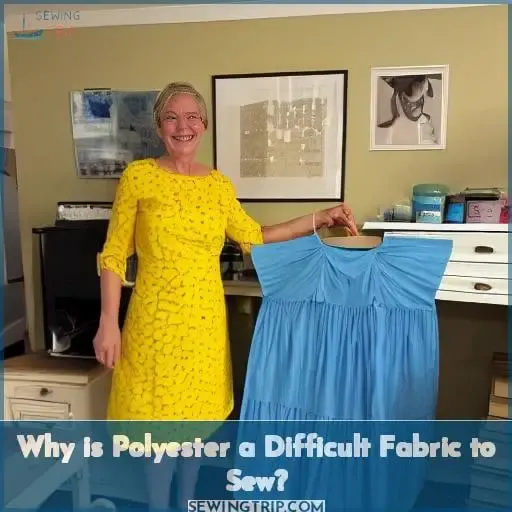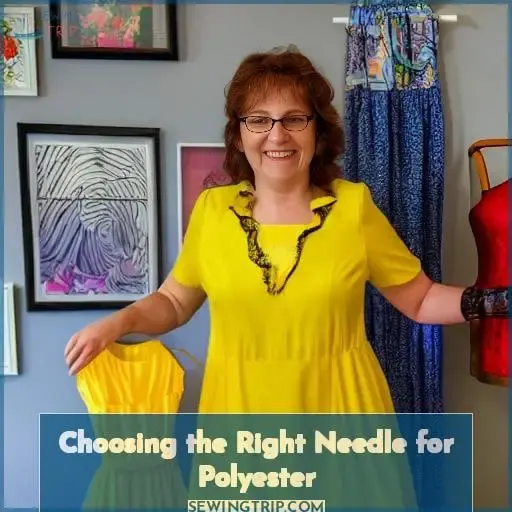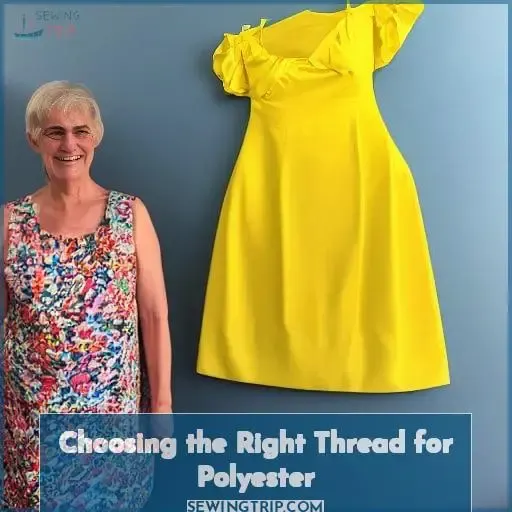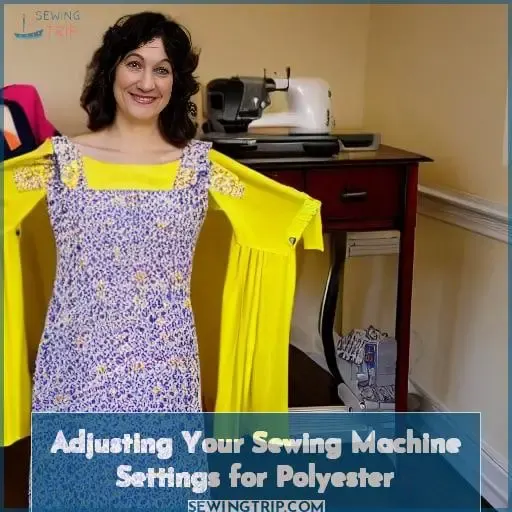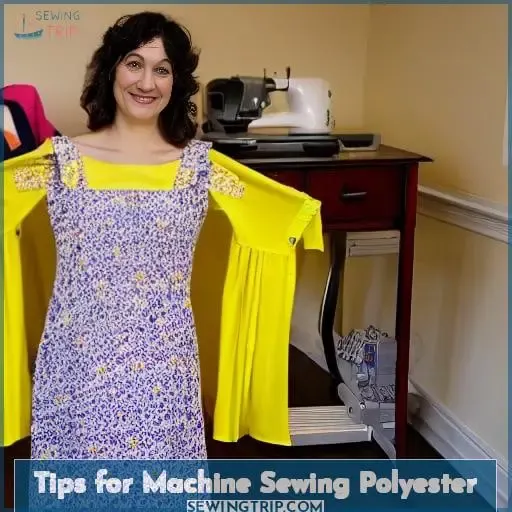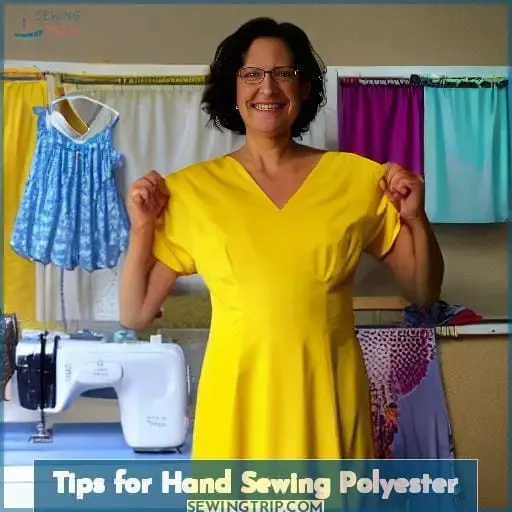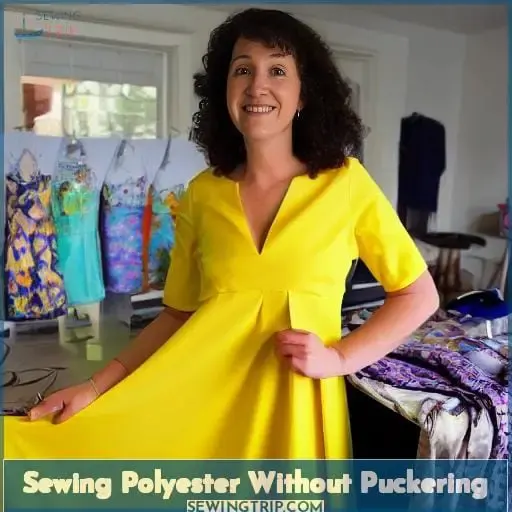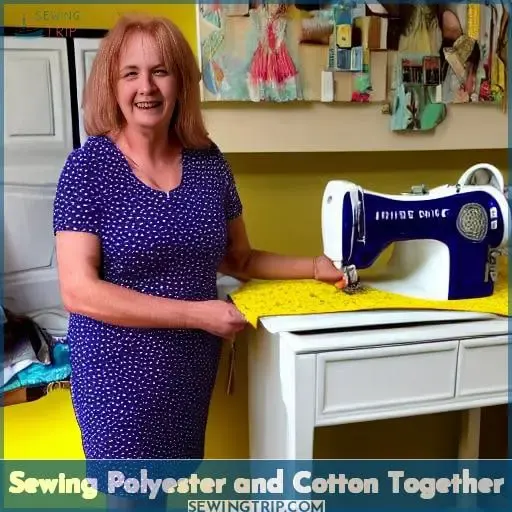This site is supported by our readers. We may earn a commission, at no cost to you, if you purchase through links.
Have you ever stood in front of a shelf full of polyester fabric, longing to bring the beautiful pieces home but intimidated by its slippery and silky texture? If so, you’re not alone. Experienced sewers know that sewing with polyester can be tricky – even daunting – if they don’t have the right set up. But don’t fear! With some simple tips and tricks, this unique material will soon be a breeze for your next project.
Needles, threads, and settings – I’m here to help you master how to sew polyester like an expert!
Start by using the right needle. Universal needles are good for polyester, but a Microtex needle is best. This type is designed for tighter woven fabrics like polyester.
Next, use the right thread. Polyester thread is available and suggested, but if you don’t have any, you can use cotton thread too. Just make sure it’s not too thick.
Finally, adjust your machine settings. Set your machine to a short stitch length, and use a light pressure foot for this slippery fabric.
With these tips, you’ll be able to sew polyester like a pro!
Table Of Contents
- What is Polyester?
- Why is Polyester a Difficult Fabric to Sew?
- Choosing the Right Needle for Polyester
- Choosing the Right Thread for Polyester
- Adjusting Your Sewing Machine Settings for Polyester
- Tips for Machine Sewing Polyester
- Tips for Hand Sewing Polyester
- Sewing Polyester Without Puckering
- Sewing Polyester and Cotton Together
- Frequently Asked Questions (FAQs)
- Conclusion
What is Polyester?
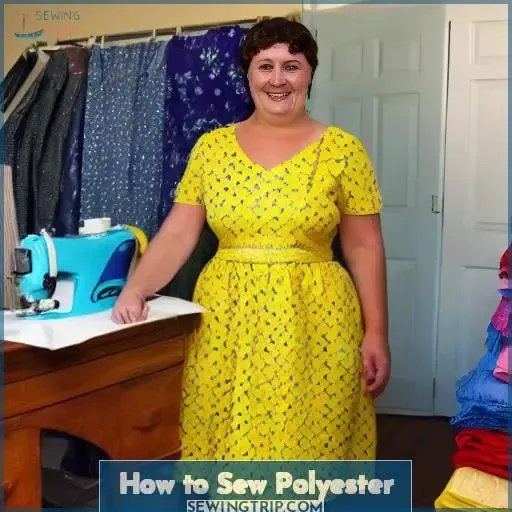
You may be familiar with the term ‘polyester’. But it’s important to understand what this fabric consists of before you begin sewing. Polyester is a synthetic fiber created through polymerization of petroleum-derived ethylene glycol and terephthalic acid. These are combined to form long chain polymers. It has excellent strength and durability, making it well suited for use in clothing and home furnishings.
The fabrics made from polyester fibers also have good resistance against shrinkage, fading or creasing when subjected to textile finishing processes. These include dyeing or printing techniques. They can also resist colorfastness, even after multiple wash cycles. This is due to the strong molecular bonds between individual fibers, which prevent them from getting dislodged easily during the cleaning process.
When using a sewing machine on polyester material, ensure your thread type matches the fabric composition. The most common types used include all-purpose threads (100% cotton), stretch needles (for knits), and specialised threads designed specifically for working with synthetics like polyesters- like top stitch and quilting thread. You could also consider double needle hems, as they create two lines of stitching at once, ensuring extra stability without compromising movement in lightweight materials like sheer silks and chiffons.
Why is Polyester a Difficult Fabric to Sew?
You’ll find that polyester can be a slippery devil to handle, so having the right tools and techniques is key! One of the biggest challenges when it comes to sewing with polyester fabric is thread tension. If your stitch tension isn’t just right u2013 not too tight or loose u2013 you’ll end up with uneven stitches on either side of the seam.
Another problem faced when working with this type of fabric is its tendency for shrinkage; if you don’t use a longer stitch length while sewing, there’s a risk that it will pucker after washing.
The type of needle used in combination with polyester thread also makes an impact; choose one suited for lightweight fabrics like 90/14 size ballpoint needles made specifically for synthetic fibers such as nylon and polyester threads. Additionally, using presser feet such as walking foot helps maintain even feeding from both layers which prevents puckering or pleating along seams lines.
Lastly, practice making French seaming on scrap pieces before taking on more complex projects will help make sure everything goes smoothly once those precious yards get cut into garments:
- Set your machine’s stitch length shorter than usual
- Use very light pressure while pressing seams open
- Make sure your machine has proper bobbin tension
- Choose specialty ‘poly’ threads rather than cotton ones
- Select appropriate presser foot attachments
Choosing the Right Needle for Polyester
You’ll be surprised how simple it can be to get great results when you choose the right needle for your polyester fabric! Pay close attention to thread and needle material. Choose a fresh stainless steel or titanium needle specifically for synthetic fabrics like polyester. Size should correspond with fabric weight – thinner fabrics need smaller needles, heavier weights need bigger sizes. Depending on stitches, select either a universal or ballpoint tip – cotton threads work best with standard tips, synthetic threads with ballpoint needles since they won’t break easily. Adjust sewing speed according to how quickly and accurately you want each stitch done. If accuracy’s key, slow down. If time efficiency matters more, crank up the machine’s pace. With practice and following these steps, novice sewers can produce professional-looking garments out of their favorite pieces in no time!
Choosing the Right Thread for Polyester
When it comes to sewing polyester, the best thread choice is a lightweight synthetic or cotton-wrapped polyester for strength and durability – with over 80% of sewers opting for this option!
Polyester threads are available in various weights, ranging from light (50 wt.) to extra heavy (100wt.), making them ideal for both hand stitching and machine sewing. The lighter weight threads allow you to create invisible seams on sheer fabrics like chiffon while heavier ones provide more seam stability on thicker materials such as canvas.
Additionally, when using a narrow zig-zag stitch setting on your machine, ensure the foot pressure isn’t too high; otherwise, you’ll break needles or have issues with skipped stitches.
Always opt for a needle size specifically designed for working with polyester fabrics – usually between 70/10 – 90/14 depending on how thick the material is.
Adjusting Your Sewing Machine Settings for Polyester
To get the best results, adjust your sewing machine settings specifically for polyester fabric – it’ll make all the difference! Depending on your machine, certain stitch and tension settings work better. A straight line stitch is recommended – use a synthetic setting if available. Look for specially designed polyester threads, as they’re stronger than standard cotton options and reduce skipped stitches. Setting the correct tension is key – usually lower tensions work well on thinner fabrics like silk and sheer synthetics, like polyester chiffon or georgette. So, be mindful of pressure when stitching these delicate materials together for professional-looking results.
Tips for Machine Sewing Polyester
With polyester, it can be tricky to get the desired results – but with these tips you’ll soon be sewing like a pro! Iron your fabric before beginning any project. Set the machine’s temp. according to the type of polyester and use steam when necessary. To prevent fraying, make sure all seam finishes are neat and secure. French seams can help too, if using semi-sheer material.
Invest in a presser foot for extra grip. Select small needles specifically designed for machine sewing with polyester thread. Adjust your sewing machine‘s pressure settings for firm tension without puckers.
Pay attention when inserting zippers and making buttonholes. Use an appropriate stitch length – not more than 2mm – to avoid loose stitches along edges of hems and waistbands.
Keep trying until you achieve success! Practice makes perfect.
Tips for Hand Sewing Polyester
Now that you know the basics of machine sewing polyester, let’s move on to hand stitching – it’s easier than you think!
Before beginning any project with your stash of cheap polyester material, pre-treat all fabrics by ironing them and pressing seams. This will help stabilize edges and prevent fraying.
Take time during cutting fabric for projects to iron fold lines for a more precise look when finished.
The feel of polyester can be slippery, so use short stitches when hand sewing with a strong thread such as a 100% Polyester or Nylon thread; this will keep pieces secure without adding bulkiness in the seam allowance area.
You can also consider reinforcing edges using French seams or double needle hems if desired. These techniques are especially useful when working with semi-sheer fabrics like chiffon or georgette, which have extra drape due to their thinness. Or try satin backed crepe de Chine, which is heavier weight yet still has excellent drape characteristics too!
Sewing Polyester Without Puckering
To ensure your polyester fabric stays smooth and flat while sewing, use a longer stitch length and avoid stretching the fabric. Pre-washing is essential for synthetic fabrics, to reduce any shrinkage when finished that can cause puckering in the seams. Select a good quality of polyester thread and smaller needles for best results.
When cutting, don’t pull too hard which could stretch or distort shape. Trim off loose threads before pressing, and adjust tension settings to prevent bunching up when stitching together multiple pieces. With some patience and practice, anyone should be able to tackle their first time sewing with confidence. Tips tailored towards synthetics like polyester blends should help!
Sewing Polyester and Cotton Together
You’ll need to tread carefully when stitching polyester and cotton together – it’s like walking a tightrope! Choose a compatible combination of colors, fabrics, and ironing techniques. French seams are recommended for semi-sheer polyester fabrics because they give strength without bulkiness. Opt for presser feet designed for synthetic woven fabric like knit polyesters rather than generic pressers for natural fibers. Use thread that matches the fiber content – preferably 100% polyester – or risk shrinkage or discoloration due to chemical interactions between dissimilar threads and fabrics. Stabilizers may be necessary if you find puckering is occurring during construction. They provide support while sewing even thick layers of fabric so long seams lay flat, resulting in higher quality garments crafted with ease!
Frequently Asked Questions (FAQs)
Is a walking foot necessary for sewing with polyester?
You might be wondering if a walking foot is necessary when sewing with polyester, the most popular human-made fabric. As you know, it can be slippery and thin, making it tricky to work with. A walking foot will certainly help keep everything in place while you sew.
Pay attention to seam allowances and needle types as well as thread tension for best results when using a narrow zigzag stitch on your polyester fabrics – even semi-sheer ones!
There are some useful little tips that may make all the difference, so don’t let bad experiences or negative posts discourage you. Just start on a scrap of cloth first if need be!
Should I use temporary spray adhesive when sewing with polyester?
Sewing with polyester fabric can be tricky, especially when using slippery, thin and silky material. But don’t worry! Temporary spray adhesive is a great way to help you tackle this challenge. It’ll keep your lining adhesives in place and prevent seam slippage from the synthetic fibers.
Depending on tension settings and interfacing types used for your project, you may need to adjust thread stretch for small fibers. But Love Sew Family has tips on that too! With the right techniques and some trial-and-error, soon sewing with polyester items won’t feel like such a daunting task. In fact, it could become one of your favorite fabrics to work with!
Is backstitching necessary when sewing with polyester?
When it comes to sewing with polyester fabric, backstitching is essential. It helps provide seamless joining and prevents fraying, while also allowing for better tension control of your stitch length. Choosing the right type of thread is key. Different settings may be required depending on the polyester fabric.
A double-needle hem or French seam can give your project a professional finish. But if done incorrectly, they won’t offer much protection against fraying.
The best way to get a good grasp on how these techniques work together is to start off small. Grab some scrap material from your stash and practice until you find the preferred method that works best for you.
Can I use a double needle hem when sewing with polyester?
Sewing with polyester fabric can be tricky, but don’t fear it! A double needle hem is one way to make sure your finished product looks professional. Needle types are important when stitching up polyester. Make sure the needles you use are sharp and appropriate for the thread and fabric weight – lighter threads work better on lightweight fabrics like silky or sheer polyesters. Consider what kind of presser foot works best for your project; try a walking foot if necessary. When cutting tools, pressing tools, or new sewing machines are involved, remember cool wash settings can help keep delicate materials from being damaged in production. Take care not to get stuck in the hole plate as this may cause puckering. Practice on scraps at first, before tackling larger pieces near an edge of your work surface just in case!
Is it possible to use French seams on semi-sheer polyester?
Yes, it’s possible to use French seams on semi-sheer polyester. But it’s tricky. Tension control is key. It’s stretchy and sheer, so the most experienced sewer may find it difficult. Have the right tools to ensure friction between pattern pieces while sewing. A walking foot or temporary spray adhesive for extra grip. Patience and practice will help you master sewing with polyester.
Conclusion
Sewing with polyester can be daunting. But with the right tools, techniques, and a little patience, you can become a pro. Don’t let negative posts scare you away. With the right needle, thread, settings, and tricks like using a walking foot, temporary adhesive, and a double needle hem, you’ll be able to sew your projects like a pro.
If you’re ever stuck, don’t be afraid to start with a scrap of fabric to practice the techniques. With the right know-how, sewing with polyester can be a breeze.

